Having read my previous blogs, you might have the impression that all of our efforts of discovery on these unique islands are limited to the high forests and other habitats of the terrestrial environment, and that most of the neat unknown and undescribed stuff is to be found on land. Such is definitely not the case. The marine and freshwater realms have not escaped our attention, and they probably contain as many biological mysteries as the land does, maybe more. Let’s not forget that the inshore marine communities, just like the aerial parts of the islands, have been isolated for millions of years.  M. Campbell (Willamette Univ.) and Dr. Iwamoto on Sao Tome GG II (Photo. RCD) The offshore fisheries of São Tomé and Príncipe are very rich but poorly protected; I have been told that the government cannot afford to monitor the trawling of other countries within their exclusive economic zone, and this is a tragedy not only for economic reasons. The fact is that we still do not fully understand the inshore marine fauna of this unique archipelago.
M. Campbell (Willamette Univ.) and Dr. Iwamoto on Sao Tome GG II (Photo. RCD) The offshore fisheries of São Tomé and Príncipe are very rich but poorly protected; I have been told that the government cannot afford to monitor the trawling of other countries within their exclusive economic zone, and this is a tragedy not only for economic reasons. The fact is that we still do not fully understand the inshore marine fauna of this unique archipelago. 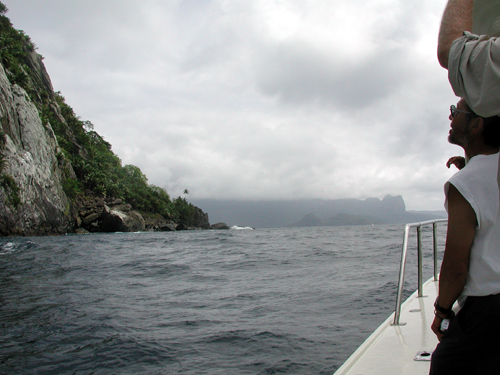 Tomio off the Jockey’s Bonnet, Principe. GGII (Photo RCD) Dr. Tomio Iwamoto, chair of the CAS Ichthyology Department was a member of both GG I and GG II. Much of his work in 2001 and 2006 involved sampling the many freshwater rivers of both islands (which I will describe later); but he made some of his most interesting discoveries simply by interacting with the local fishermen.
Tomio off the Jockey’s Bonnet, Principe. GGII (Photo RCD) Dr. Tomio Iwamoto, chair of the CAS Ichthyology Department was a member of both GG I and GG II. Much of his work in 2001 and 2006 involved sampling the many freshwater rivers of both islands (which I will describe later); but he made some of his most interesting discoveries simply by interacting with the local fishermen. 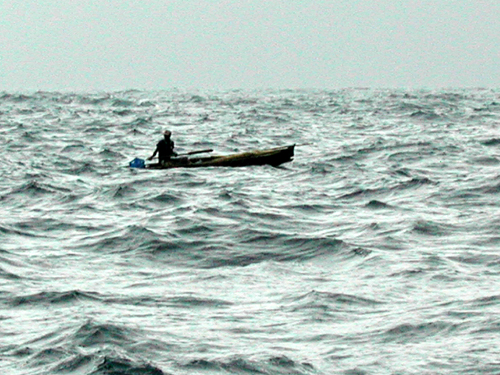 Fisherman way offshore, Principe. GG I (RCD Photo).
Fisherman way offshore, Principe. GG I (RCD Photo).  Fishermen off Ilhéu das Cabras, Sao Tome. GGII (photo: R. Van Syoc) For instance one day during GG I , Tomio and I watched a group of fishermen seining from Praia Lagarto on the northwest cove of São Tomé island. Tomio asked them if he could examine their catch and discovered several species of fish not known to occur in São Tomé and Príncipe. He bought them from the fishermen on the spot and preserved them as specimens.
Fishermen off Ilhéu das Cabras, Sao Tome. GGII (photo: R. Van Syoc) For instance one day during GG I , Tomio and I watched a group of fishermen seining from Praia Lagarto on the northwest cove of São Tomé island. Tomio asked them if he could examine their catch and discovered several species of fish not known to occur in São Tomé and Príncipe. He bought them from the fishermen on the spot and preserved them as specimens. 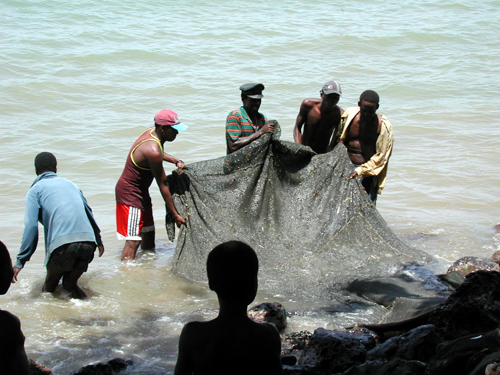 [Beach seining, Sao Tome. GGI (RCD photo) Each day in the afternoon , the fishing boats arrive on the beach of Baia de Ana Chavez, directly adjacent to the central market of São Tomé city. Many of the city’s citizens flock to the beach to buy directly from the fishermen.
[Beach seining, Sao Tome. GGI (RCD photo) Each day in the afternoon , the fishing boats arrive on the beach of Baia de Ana Chavez, directly adjacent to the central market of São Tomé city. Many of the city’s citizens flock to the beach to buy directly from the fishermen.  Arrival of the fishing fleet. GG I (J. Ledford phot)
Arrival of the fishing fleet. GG I (J. Ledford phot)  Buying directly off the boats. GG I (J. Ledford phot.) We discovered that the fishermen would allow us to examine the contents of their nets while they were sorting through their catch for sale and would sell us whatever we wanted. Tomio employed the same “field technique” on Príncipe during in 2006 and as a result, he was able to add more than sixteen species of marine fishes to the current list of species known from the islands!
Buying directly off the boats. GG I (J. Ledford phot.) We discovered that the fishermen would allow us to examine the contents of their nets while they were sorting through their catch for sale and would sell us whatever we wanted. Tomio employed the same “field technique” on Príncipe during in 2006 and as a result, he was able to add more than sixteen species of marine fishes to the current list of species known from the islands! 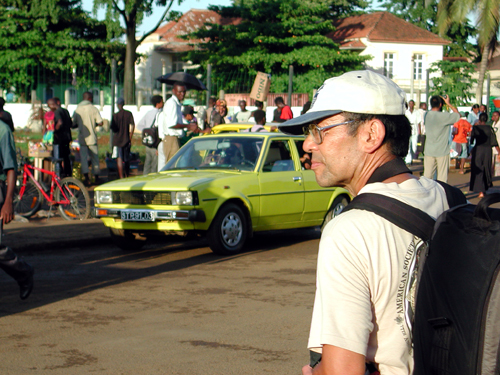 Tomio heads for the beach and the boats. GG I (J. Ledford phot.) In 2006 (GG II), the team was joined by Drs. Gary Williams and Robert Van Syoc, both of the Academy’s Department of Invertebrate Zoology and Geology. Bob is a specialist on the world’s barnacles and Gary is one of the foremost authorities on various groups of corals. Together the two surveyed the waters of São Tomé with the expert help of Jean-Luis Testori, owner, divemaster and skipper of Club Maxel on the big island.
Tomio heads for the beach and the boats. GG I (J. Ledford phot.) In 2006 (GG II), the team was joined by Drs. Gary Williams and Robert Van Syoc, both of the Academy’s Department of Invertebrate Zoology and Geology. Bob is a specialist on the world’s barnacles and Gary is one of the foremost authorities on various groups of corals. Together the two surveyed the waters of São Tomé with the expert help of Jean-Luis Testori, owner, divemaster and skipper of Club Maxel on the big island.  Dr. Gary Williams. GG II B Van Syoc photo)
Dr. Gary Williams. GG II B Van Syoc photo) 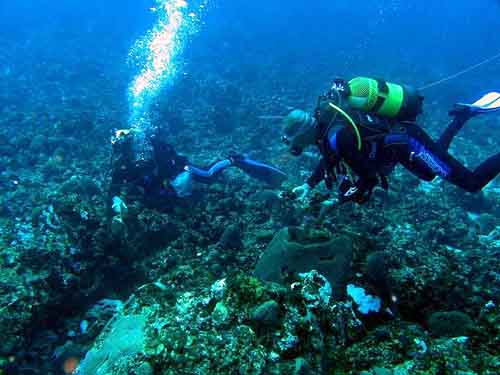 [Gary (left) and Jean-Luis collecting, Sao Tome. GGII (B.Van Syoc phot.)
[Gary (left) and Jean-Luis collecting, Sao Tome. GGII (B.Van Syoc phot.)  Eunicella, a sea fan of Sao Tome. GG II (B. Van Syoc phot.) Gary collected twelve species of octocorals including eleven sea fans, also known as gorgonians; all of these species are endemic to the eastern tropical Atlantic. At the same time, Bob Van Syoc made a synoptic survey of the São Tomé barnacles. All of the barnacle species so far identified are known from oceanic islands (see the first blog on oceanic vs continental islands), none of the intertidal genera or species commonly associated with continental shores have been found on Sao Tome. Bob and Gary will return to São Tomé and Príncipe on GG III(B) in January, 2009 and both are eager to sample and compare the same kinds of organisms inhabiting the much older inshore marine communities of Príncipe.
Eunicella, a sea fan of Sao Tome. GG II (B. Van Syoc phot.) Gary collected twelve species of octocorals including eleven sea fans, also known as gorgonians; all of these species are endemic to the eastern tropical Atlantic. At the same time, Bob Van Syoc made a synoptic survey of the São Tomé barnacles. All of the barnacle species so far identified are known from oceanic islands (see the first blog on oceanic vs continental islands), none of the intertidal genera or species commonly associated with continental shores have been found on Sao Tome. Bob and Gary will return to São Tomé and Príncipe on GG III(B) in January, 2009 and both are eager to sample and compare the same kinds of organisms inhabiting the much older inshore marine communities of Príncipe.  Dr. Bob Van Syoc, barnacle specialist (R. Van Syoc phot!)
Dr. Bob Van Syoc, barnacle specialist (R. Van Syoc phot!)  Stony coral with barnacle (arrow) Sao Tome. GG II (B. Van Syoc phot) One of the most exciting events during GG II was the discovery by Bob of what appears to be an undescribed species of barnacle of the genus Conopea, which may be symbiotic with one or more of Gary’s sea fans. Dana Carrison, Dr. Van Syoc’s graduate student at San Francisco State University, is in the process of describing this new species for her MSc. degree and will join GG III(B) on the expedition to Príncipe to search for similar species and relationships.
Stony coral with barnacle (arrow) Sao Tome. GG II (B. Van Syoc phot) One of the most exciting events during GG II was the discovery by Bob of what appears to be an undescribed species of barnacle of the genus Conopea, which may be symbiotic with one or more of Gary’s sea fans. Dana Carrison, Dr. Van Syoc’s graduate student at San Francisco State University, is in the process of describing this new species for her MSc. degree and will join GG III(B) on the expedition to Príncipe to search for similar species and relationships. 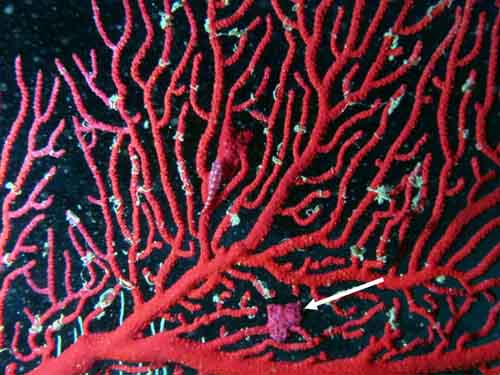 Gorgonian (sea fan) with Conopea (arrow). GG II B. Van Syoc phot)
Gorgonian (sea fan) with Conopea (arrow). GG II B. Van Syoc phot) 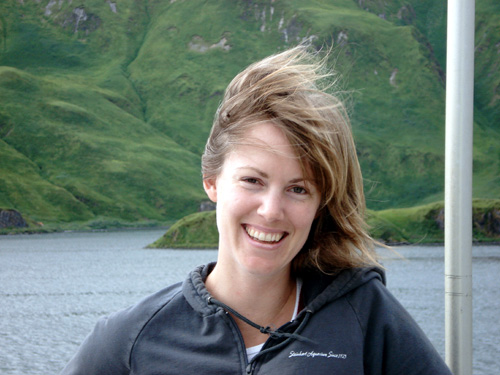 Dana Carrison, Bob's graduate student from San Francisco State U. (NOAA phot) Dr. Marta Pola-Perez is an authority on nudibranchs, or sea slugs, and will be along on GG III (B) as well. Marta is a post-doctoral fellow of the Department of Invertebrate Zoology and Geology and will be making the Academy’s first survey of these spectacular creatures in the Gulf of Guinea.
Dana Carrison, Bob's graduate student from San Francisco State U. (NOAA phot) Dr. Marta Pola-Perez is an authority on nudibranchs, or sea slugs, and will be along on GG III (B) as well. Marta is a post-doctoral fellow of the Department of Invertebrate Zoology and Geology and will be making the Academy’s first survey of these spectacular creatures in the Gulf of Guinea. 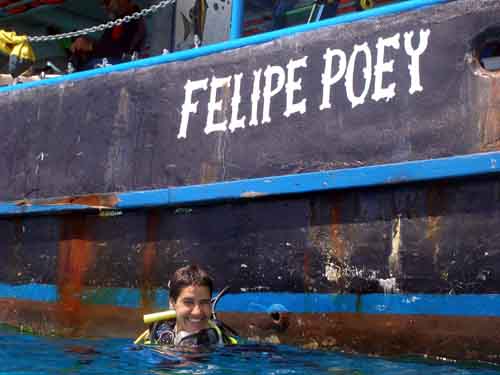 Dr. Marta Pola Perez in Cuba
Dr. Marta Pola Perez in Cuba  Tambja tentaculata, a nudibranch from Guam (M. Pola-Perez phot) Finally, the Gulf of Guinea III marine expedition of early 2009 will include two additional new scientists: Dr. John McCosker, Chair of Aquatic Biology at the Academy, is perhaps most famous as an authority on great white sharks; in reality he is one the world’s leading experts on eels, his real love. After the group finishes work on Príncipe, John will probably return to São Tomé to look for eels.
Tambja tentaculata, a nudibranch from Guam (M. Pola-Perez phot) Finally, the Gulf of Guinea III marine expedition of early 2009 will include two additional new scientists: Dr. John McCosker, Chair of Aquatic Biology at the Academy, is perhaps most famous as an authority on great white sharks; in reality he is one the world’s leading experts on eels, his real love. After the group finishes work on Príncipe, John will probably return to São Tomé to look for eels. 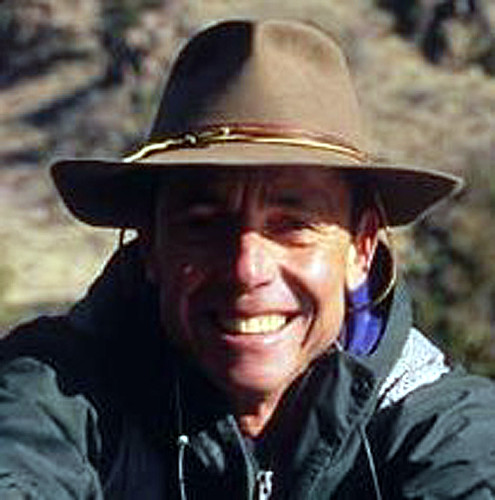 Dr. John McCosker, eel specialist (P. McCosker phot)
Dr. John McCosker, eel specialist (P. McCosker phot)  Brachisomophis, a snake eel described from Principe. (P. Wirth phot) Dr. McCosker will be joined and assisted by David Catania, Collections Manager of our Ichthyology Department. David has collected fish all over the world, and while accompanying Dr. McCosker during SCUBA operations, he also plans to continue combing the São Tomé fish market and meeting the fishing boats as did Dr. Iwamoto during GG I and GG II.
Brachisomophis, a snake eel described from Principe. (P. Wirth phot) Dr. McCosker will be joined and assisted by David Catania, Collections Manager of our Ichthyology Department. David has collected fish all over the world, and while accompanying Dr. McCosker during SCUBA operations, he also plans to continue combing the São Tomé fish market and meeting the fishing boats as did Dr. Iwamoto during GG I and GG II. 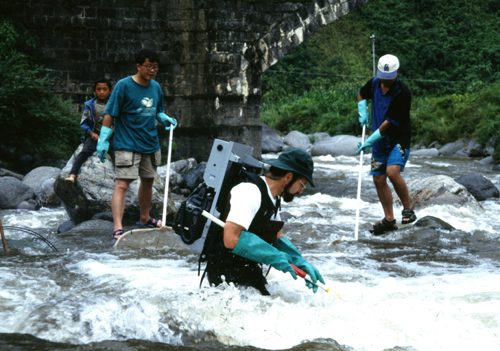 Catania electroshock fishing in Yunnan (D. Lin phot) Who knows how many undescribed species are caught each day by the hard-working fishermen of the Republic of São Tomé and Príncipe? The islands continue to amaze and enchant-- There is much more coming. The parting shot:
Catania electroshock fishing in Yunnan (D. Lin phot) Who knows how many undescribed species are caught each day by the hard-working fishermen of the Republic of São Tomé and Príncipe? The islands continue to amaze and enchant-- There is much more coming. The parting shot:  Nova Cuba, Principe. GG III (Weckerphoto) PARTNERS We gratefully acknowledge the support of the G. Lindsay Field Research Fund and the Research Investment Fund of the California Academy of Sciences, the Société de Conservation et Développement (SCD) for logistics, ground transportation and lodging, STePUP of Sao Tome http://www.stepup.st/ and especially the generosity of three private individuals, George F. Breed, Gerry F. Ohrstrom and Timothy M. Muller, for making these expeditions possible.
Nova Cuba, Principe. GG III (Weckerphoto) PARTNERS We gratefully acknowledge the support of the G. Lindsay Field Research Fund and the Research Investment Fund of the California Academy of Sciences, the Société de Conservation et Développement (SCD) for logistics, ground transportation and lodging, STePUP of Sao Tome http://www.stepup.st/ and especially the generosity of three private individuals, George F. Breed, Gerry F. Ohrstrom and Timothy M. Muller, for making these expeditions possible.